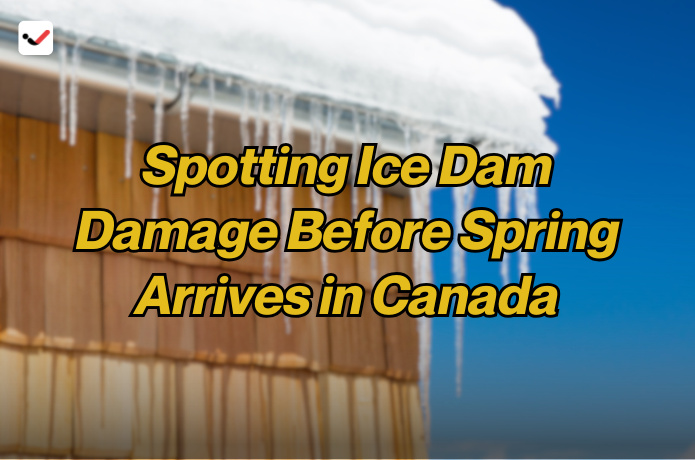Spotting Ice Dam Damage Before Spring Arrives in Canada
Spotting Ice Dam Damage Before Spring Arrives in Canada

As winter starts to fade and spring begins to warm up Canadian neighbourhoods, homeowners should start checking their homes for signs of winter damage. One of the most common problems during the colder months is ice dam damage. Ice dams can form on roofs when snow melts, runs down, and refreezes at the roof’s edge, causing water to back up under the shingles. This can lead to serious damage to your roof, attic, walls, and ceilings—especially if it goes unnoticed.
Spotting ice dam damage early can help homeowners avoid expensive repairs later on. As the snow melts and temperatures rise, now is the perfect time to inspect your home and catch any problems caused by winter weather. Knowing what to look for and where to look can save you from costly damage and help keep your home safe, dry, and ready for the warmer season. In this article, we’ll explain how to identify signs of ice dam damage, where to check, and what to do if you find trouble.
What Are Ice Dams?
Ice dams are ridges of ice that build up along the edge of a roof. They form when heat from inside the house melts the snow on the roof, and the melted water runs down to the colder roof edge where it refreezes. Over time, this frozen water builds up, blocking new melted snow from draining off the roof properly. When water gets trapped behind the dam, it can seep under the roof shingles and leak into the home.
In Canada’s cold climate, ice dams are a common winter issue, especially in homes with poor insulation or uneven roof temperatures. Older homes and houses with complex roof shapes are more likely to have this problem. The key is to act fast once the snow starts to melt and to inspect the home for warning signs of water damage caused by ice dams.
Signs of Ice Dam Damage on the Roof
One of the first places to check for ice dam damage is the roof itself. When the snow starts to melt, inspect the roof from the ground or with binoculars. Look for missing shingles, cracked tiles, or any signs of warping. Dark spots or streaks on the shingles may also signal water has seeped underneath the surface.
Another sign is sagging or drooping roof lines. If parts of your roof appear uneven or slightly sunken, it could mean water has soaked the wooden structure below. Pay special attention to the eaves and valleys—these areas are most vulnerable to ice buildup and damage. If it’s safe to do so, inspect your gutters and downspouts for signs of ice blockage or damage from heavy icicles.
Warning Signs Inside the Home
Ice dam damage doesn’t stop at the roof—it often shows up inside the house too. Water leaks from ice dams can cause stains or bubbling paint on ceilings and upper walls. If you notice water spots that weren’t there before, especially on exterior walls or ceiling corners, this could be a sign that melted water has gotten inside.
Peeling paint, warped wood trim, or musty smells in the attic or upstairs rooms can also be early signs of moisture damage. In some cases, mould may begin to grow in damp areas, which can lead to health issues if not addressed quickly. If you suspect damage but can’t see it, consider using a moisture meter or calling a roofing expert for an inspection.
Checking the Attic for Ice Dam Leaks
Your attic can offer clues about hidden ice dam damage. During early spring, go up into your attic with a flashlight and carefully look for wet insulation, water stains on the wood, or frost buildup. Wet or compressed insulation loses its ability to keep your home warm and may need to be replaced.
Check the areas near vents, chimneys, and where the roof meets the walls—these are common spots for leaks. If you smell mildew or notice a drop in attic temperature, that could also point to water entering from above. Catching attic leaks early can prevent further water damage and save money on repairs.
How Ice Dam Damage Affects Your Home
Left unchecked, ice dam damage can lead to serious problems. Over time, water can rot roof decks, damage insulation, and even weaken the structure of your home. Walls and ceilings may need to be replaced if water damage spreads too far. Electrical wiring hidden in walls could also be at risk if water seeps in.
Another common issue is the growth of mould, especially in areas where water has collected behind walls or under floors. Mould not only damages your home but can also cause breathing problems and allergies for those living inside. Spotting ice dam damage early and acting quickly is key to keeping your home healthy and safe.
What to Do If You Find Damage
If you discover signs of ice dam damage, it’s important to act quickly. Start by drying out the area as much as possible. Use fans, open windows, or a dehumidifier to remove moisture. Remove any wet insulation and materials that can't be saved. For minor roof damage, temporary repairs like roofing tar or waterproof tape may help until a professional can take a look.
In most cases, it’s best to contact a licensed roofing contractor or home inspector who understands Canadian winters and ice dam issues. They can check your roof, attic, and walls more thoroughly and suggest long-term solutions. In some cases, your home insurance may cover the cost of damage caused by ice dams, so check your policy or contact your provider for details.
Preventing Future Ice Dams
Once the damage is fixed, it’s time to prevent future problems. Good attic insulation and ventilation are key to stopping ice dams from forming. When your attic stays cool, snow on the roof melts more evenly and doesn’t refreeze at the edges. Make sure your attic has proper airflow with working vents and no air leaks from the rooms below.
Installing a water and ice shield under your roof shingles is another smart move. This adds an extra layer of protection in areas most at risk of leaks. You can also use heat cables or roof rakes during heavy snowfall to keep ice from building up at the roof edge. Regular roof maintenance, especially before winter and after it ends, will go a long way in protecting your home.
Spring in Canada is a great time to check for signs of winter damage, especially when it comes to ice dams. From roof leaks to attic stains and peeling paint, the signs of damage can start small but grow quickly if ignored. Spotting the warning signs early and making necessary repairs can protect your home and prevent bigger problems in the future.
Keeping your roof, attic, and walls in good shape is part of smart home maintenance in cold climates. With a careful inspection and a few simple tools, homeowners can stop ice dam damage in its tracks and enjoy the changing seasons with peace of mind. Whether you handle it yourself or call in an expert, the effort you make this spring will help keep your home strong and dry year after year.

